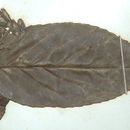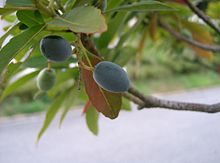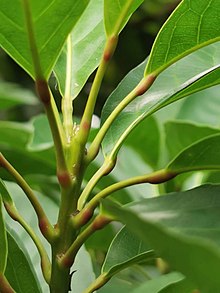zh-TW
在導航的名稱


A small tree to 8 metres tall, found only on Lord Howe Island. Flowering occurs from mid February to March.
Elaeocarpus is a genus of nearly five hundred species of flowering plants in the family Elaeocarpaceae native to the Western Indian Ocean, Tropical and Subtropical Asia, and the Pacific. Plants in the genus Elaeocarpus are trees or shrubs with simple leaves, flowers with four or five petals usually, and usually blue fruit.



Plants in the genus Elaeocarpus are mostly evergreen trees or shrubs, a few are epiphytes or lianes, and some are briefly deciduous. The leaves are arranged alternately, simple (strictly compound with only one leaflet) with a swelling where the petiole meets the lamina, often have toothed edges, usually have prominent veins and often turn red before falling. The flowers are usually arranged in a raceme, usually bisexual, have four or five sepals and petals and many stamens. The petals usually have finely-divided, linear lobes. The fruit is a oval to spherical drupe that is usually blue, sometimes black, with a sculptured endocarp.[2][3][4]
The genus Elaeocarpus was first formally described in 1753 by Carl Linnaeus in Species Plantarum,[5][6] although Johannes Burman published an illustration of "Elaecarpus serrata" in his book Thesaurus zeylanicus, but without a description of the genus.[7] The first species described by Linnaeus (the type species) was Elaeocarpus serratus.[5] The name Elaeocarpus is derived from Greek and means ‘olive-fruited’.[8]
See also List of Elaeocarpus species
There are about 488 species of Elaeocarpus, found on the islands of the western Indian Ocean, in tropical and subtropical Asia, Australia and on Pacific islands.[9]
Elaeocarpus is a genus of nearly five hundred species of flowering plants in the family Elaeocarpaceae native to the Western Indian Ocean, Tropical and Subtropical Asia, and the Pacific. Plants in the genus Elaeocarpus are trees or shrubs with simple leaves, flowers with four or five petals usually, and usually blue fruit.
 Elaeocarpus sylvestris fruits
Elaeocarpus sylvestris fruits  Elaeocarpus dentatus foliage
Elaeocarpus dentatus foliage  Elaeocarpus grandiflorus flowers, at Munnar
Elaeocarpus grandiflorus flowers, at Munnar  Elaeocarpus tuberculatus
Elaeocarpus tuberculatus  Pulvina at both ends of the petiole. Elaeocarpus multiflorus
Pulvina at both ends of the petiole. Elaeocarpus multiflorus